As we grew up, read great books, and watched movies of faraway lands, it ignited an idea. An idea that we could visit the world’s most unique, mysterious, and exotic lands. It doesn’t get any more unique, more mysterious, more exotic than Easter Island.
The UNESCO World Heritage Centre committee must have felt the same way since they inscribed this island, along with a few of its neighbors, on the world heritage list in 1995. To this day, Easter Island is one of my all-time favorite places I’ve visited.
Rapa Nui National Park – Chile
Discovered and claimed on Easter Sunday on April 5, 1722, Jacob Roggeveen aptly named the island for the Europeans. Just like many other islands, whether they understood the native tongue or not, they ignored the indigenous name of Rapa Nui, meaning “Great Rapa” and gave it the first name that came to them.
Immediately upon arrival, the Europeans came face to face with a stone-age culture. As they wandered around, finding the spectacular cliffs, extinct volcano craters, and the beautiful hills and valleys, it soon became apparent that the island was something special. It had a secret; the secret of the moai. Who were these ancient sculpters? DNA samples have proved that at least some of them are of Polynesian descent probably coming from the Marquesas.
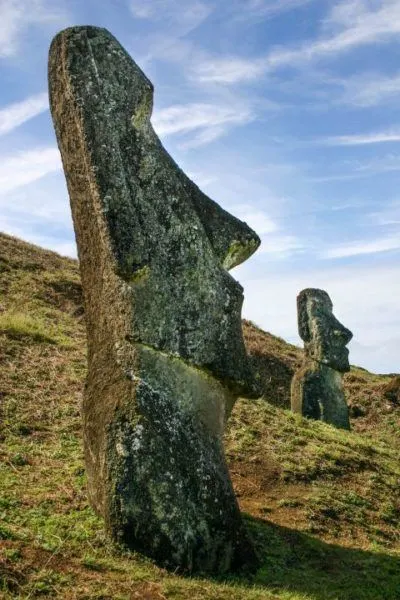
Huge basalt sculptures of a man’s body or upper torso were found in various sizes. Hundreds of these incredible and completely different pieces of art are sprinkled around the island. Elongated heads, long ears, prominent noses, and cheeky smiles, the moai have been the caretakers of the island for hundreds of years. (Check out this stunning photo journey full of amazing images!)
Surprisingly, not all the sculptures are standing, and even though almost 900 have been located, it is not possible to see all of them. At the Rano Raraku crater, the ancient people quarried the volcanic rock and right there on the spot carved the moai which were later moved to a pre-dug hole. On the sloping sides of the volcano, you can see the moai in all phases of development. One is still lying down where the carver was beginning to bring him out of the stone.
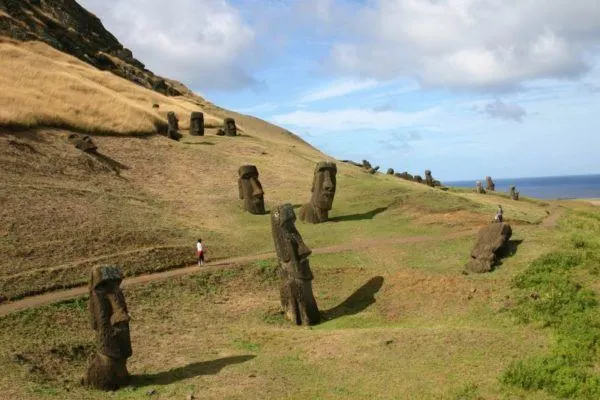
Who were the moai? One of the prevalent theories is each moai represents an ancestor so each one is completely unique. Notably there are quite a few details on each moai. Some have carvings, white eyes with black centers, made from coral and obsidian. A few of them sport a red hat, made out of a special rock found in Punapao, a small volcano. These cylindrical toppers signify a person with special rank.
As you explore the island, there are many singular moai, but there are also a few ahu or ceremonial platforms. On the platforms there stands a group of moai. These moai all face inward from the sea, protecting the inhabitants from storms and floods. Underneath the ahu, some bones and human remains have been found, although not enough. So the thought is that there was a cremation stand directly behind the ahu where the general populace was interred.
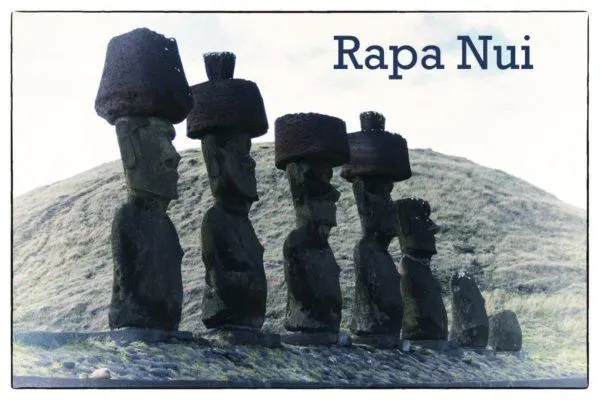
Even though a type of writing was found, it has still not been translated, a lost language. Instead a rich oral tradition recounts the founding and history of the island. From this oral history, it is said that two boats holding up to 50 people, and led by King Hotu Matu’a, first came to the island and established a colony.
This civilization survived, isolated from outside influences from the 10th through the 16th century. After that, as the population grew and spread, times inevitably started changing and with that the religion changed as well. The statue or ancestor worship was replaced by what is called the “bird-man” cult, and on top of a beautiful cliff the remains of houses, temples, and intricately carved statues of this religion can be found.
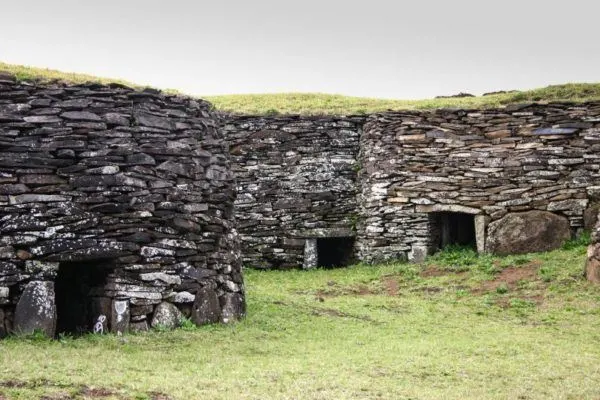
Unlike the moai, which had few permanent buildings, this cult made their village from flat stones in circles or towers with low keystones over a crawl-space opening. The village is called Orango. There are extremely complex designs carved into the rocks, one of a frog, a turtle, a bird. It is unknown what these animals represented.
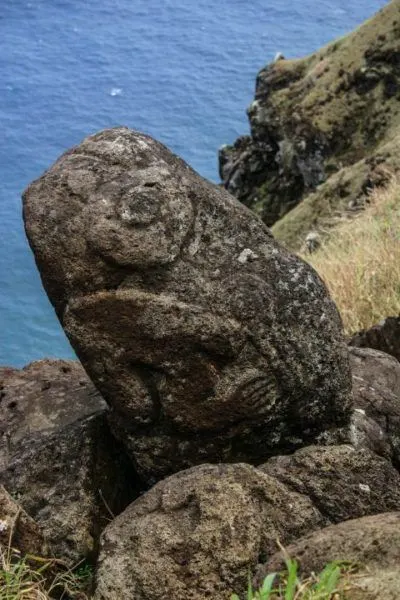
That is the amazing thing about Easter Island, it is still shrouded in so much mystery. The unknown is palpable as you wander from one archaeological site to the next. In my experience, like Orongo, many of the sites I’ve seen contain ruins of houses and villages, palaces and terraced farm lands. Never have I experienced anything like hiking through these giant heads.
Practical Information:
Easter Island is not easy to get to. It lies 4,000 kms. (2,300 mi.) off the coast of Chile. It is isolated and the air tickets are usually rather expensive. We were lucky to find a great deal out of Santiago and had the time to be spontaneous when we went, so if you have time, keep your eyes open.
LAN flies there and twice a week will also fly on to Papeete, so if planned correctly you could do both. We didn’t.
Once you arrive, the 6,000 residents have built a decent infrastructure and tourism is their main source of income, so restaurants and hotels do exist. It is imperative to pre-book, though, as sometimes the tourists outnumber the residents, and during off-season it might be harder to find a place to stay or eat. We were met at the airport by our host in true Polynesian style, with leis.
Getting around the island is easy. It is small, so riding a bike is very doable. For the four of us, we rented a car and were able to visit the sites multiple times.
There is a fee to enter the Rapa Nui National Park, but you must buy the tickets at the big ahu, Ahu Tongariki, near the crater.
There are plenty of activities to keep you busy as well, depending on the time of year you go. It’s an island, so there are plenty of beaches. There is horseback riding, swimming, snorkeling, diving, hiking, biking, and also going to the museum and watching the Rapa Nui Dance Group. All in all, one week is plenty!
Have you been to Easter Island? Any advice?
Author Bio: Corinne Vail is a travel photographer, food lover, and a perpetual traveler who has been travel writing for over 14 years. For many years she lived overseas in Germany, Japan, Turkey, South Korea, and the Netherlands teaching the children of the US. military. She’s visited over 90 countries, and she’s not stopping anytime soon.

Sophie @ Sophie's World
Sunday 15th of February 2015
Haven't been yet. Would totally love to visit. Thor Heyerdahl was doing a lot of work on Easter Island in the 80s, so the island had quite a lot of media coverage here.
Corinne Vail
Tuesday 17th of February 2015
Sophie, He was. I loved his museum in Oslo.
Margherita
Friday 13th of February 2015
Same as Shikha, I was actually talking to somebody about Easter Island this week and how much I'd love to visit it... if there ever was an inspirational post, this is it! Thanks for creating Weekend Travel Inspiration - here's to many more weeks!
Corinne Vail
Tuesday 17th of February 2015
Margherita, I really, really loved Easter Island. Thanks
Adelina
Tuesday 10th of February 2015
This is so cool. I definitely want to go to Easter Island. It's pretty expensive though I hear, but I think it's totally worth it. There is such mystery around these statues and I'd love to see them for myself.
Corinne Vail
Wednesday 11th of February 2015
Adelina, It is sooo worth it! Go!
Francisco
Tuesday 10th of February 2015
Eastern Island is definetly a place in a bucket list, living in Chile (as you mentioned) doesn't make it easier to go there..it's still far and not that cheap to travel to
Corinne Vail
Wednesday 11th of February 2015
Francisco, Yes, I'm sure that's true...good luck!
Mike
Monday 9th of February 2015
I absolutely LOVED this post as it was a first hand historical account of which I've ALWAYS wanted to read. You did a brilliant job, Corinne! I like that photo you snapped of the one still laying on it's back as it had been enroute to it's destination :)
Corinne Vail
Tuesday 10th of February 2015
Mike, One of my all-time favorite places in the world!